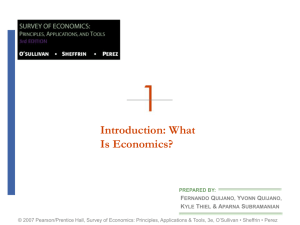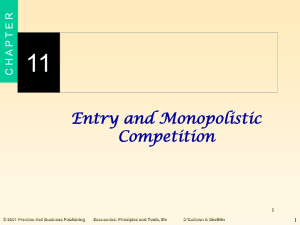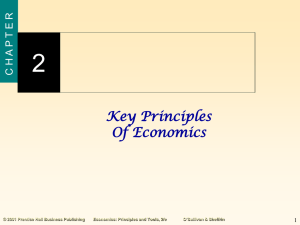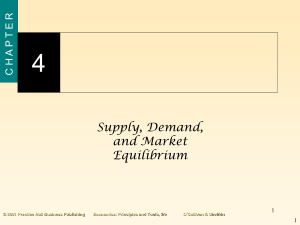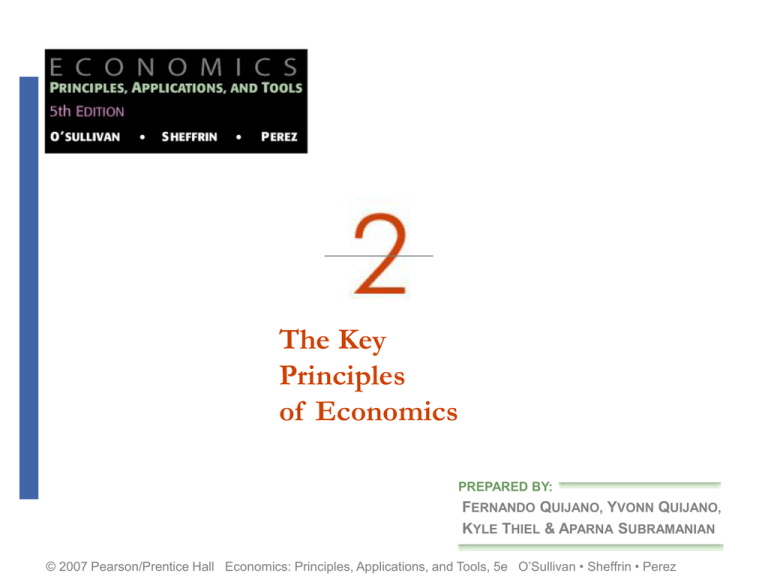
The Key
Principles
of Economics
PREPARED BY:
FERNANDO QUIJANO, YVONN QUIJANO,
KYLE THIEL & APARNA SUBRAMANIAN
© 2007 Pearson/Prentice Hall Economics: Principles, Applications, and Tools, 5e O’Sullivan • Sheffrin • Perez
chapter
1 What is the opportunity cost of running a business?
The Opportunity Costs of Time and Invested Funds
2 What are society’s trade-offs between different goods?
The Opportunity Cost of Military Spending
3 How do firms think at the margin?
Continental Airlines Uses the Marginal Principle
4 What is the rationale for specialization and exchange?
Tiger Woods and Weeds
5 Do farmers experience diminishing returns?
Fertilizer and Crop Yields
6 How does inflation affect the real minimum wage?
The Declining Real Minimum Wage
7 How does inflation affect lenders and borrowers?
Repaying Student Loans
© 2007 Pearson/Prentice Hall Economics: Principles, Applications, and Tools, 5e O’Sullivan • Sheffrin • Perez
2 of 20
chapter
2.1
THE PRINCIPLE OF OPPORTUNITY COST
• opportunity cost
What you sacrifice to get something
The Cost of College
Opportunity cost of money spent on tuition and books
$ 40,000
Opportunity cost of college time (four years working for $20,000 per year)
Economic cost or total opportunity cost
80,000
$120,000
© 2007 Pearson/Prentice Hall Economics: Principles, Applications, and Tools, 5e O’Sullivan • Sheffrin • Perez
3 of 20
chapter
THE OPPORTUNITY COSTS OF TIME AND INVESTED FUNDS
APPLYING THE CONCEPTS #1: What is the opportunity cost of
running a business?
The principle of opportunity cost applies to the cost of
running a business. Suppose you inherit $10,000 and
decide to use the money to start a lawn-care business.
Based on the following information, what’s your annual
cost of doing business?
•
Inheritance = $10,000
•
Expenses = $12,000
•
Opportunity cost of funds invested = $800
•
Opportunity cost of your time = $30,000
•
Bottom line: The cost of doing business is
$32,800 per year.
© 2007 Pearson/Prentice Hall Economics: Principles, Applications, and Tools, 5e O’Sullivan • Sheffrin • Perez
4 of 20
chapter
2.1
THE PRINCIPLE OF OPPORTUNITY COST
Opportunity Cost and the Production Possibilities Curve
FIGURE 2.1
Scarcity and the Production
Possibilities Curve
• production possibilities curve
A curve that shows the possible
combinations of products that an
economy can produce, given that its
productive resources are fully
employed and efficiently used.
© 2007 Pearson/Prentice Hall Economics: Principles, Applications, and Tools, 5e O’Sullivan • Sheffrin • Perez
5 of 20
chapter
2.1
THE PRINCIPLE OF OPPORTUNITY COST
Opportunity Cost and the Production Possibilities Curve
FIGURE 2.2
Shifting the Production
Possibilities Curve
© 2007 Pearson/Prentice Hall Economics: Principles, Applications, and Tools, 5e O’Sullivan • Sheffrin • Perez
6 of 20
chapter
THE OPPORTUNITY COST OF MILITARY SPENDING
APPLYING THE CONCEPTS #2: What are society’s trade-offs
between different goods?
We can use the principle of opportunity cost to explore the cost of military spending.
Economists estimate the cost of the Iraq War to be $540 billion.
•
Each $100 billion spent on the war could instead support one of the following
programs:
• Enroll 13 million preschool children in the Head Start program for one
year.
• Hire 1.8 million additional teachers for one year.
• Immunize all the children in less-developed countries for the next 33
years.
•
In terms of domestic security (i.e., securing ports/cargo facilities, more police,
airline screening improvement and more), the cost of implementation would be
about $31 billion – a fraction of the cost of the war.
Do the benefits from the war exceed its opportunity cost? Would money spent on
domestic security be more beneficial than the money spent on war?
© 2007 Pearson/Prentice Hall Economics: Principles, Applications, and Tools, 5e O’Sullivan • Sheffrin • Perez
7 of 20
chapter
Extra Application 8
JUST SAY COCA
Bolivia has struggled with eradicating the coca plant for decades. However, switching the
focus from eradication to alternative uses might present a real opportunity for expanding
the economy and creating jobs.
• Bolivia is attempting to paint the coca leaf in a new light in an appeal to the United
Nations to remove a 45-year old ban on the coca trade.
• President Morales believes the plant can fuel an economic revival if the country is
allowed to develop the trade in non-narcotic coca products.
• Morales maintains the plant itself is not harmful and argues that legal alternative uses
for the plant might actually reduce the illegal cultivation used to make cocaine.
• Coca makes sense economically. In fact, one of
Bolivia’s largest companies currently buys over 14
tons of coca leaf for use in teas. The company
pays about 15% more for coca leaves than
growers receive from cocaine traffickers.
Innovation and new technologies developed from the
coca plant might push the curve outward.
© 2007 Pearson/Prentice Hall Economics: Principles, Applications, and Tools, 5e O’Sullivan • Sheffrin • Perez
8 of 20
chapter
2.2
THE MARGINAL PRINCIPLE
• marginal benefit
The additional benefit resulting from
a small increase in some activity.
• marginal cost
The additional cost resulting from
a small increase in some activity.
© 2007 Pearson/Prentice Hall Economics: Principles, Applications, and Tools, 5e O’Sullivan • Sheffrin • Perez
9 of 20
chapter
2.2
THE MARGINAL PRINCIPLE
How Many Movie Sequels?
FIGURE 2.3
The Marginal Principle
and Movie Sequels
Number of
Movies
Marginal
Benefit
Marginal Cost
1
$300 million
$125 million
2
210 million
150 million
3
135 million
175 million
Renting College Facilities
Automobile Emissions Standards
© 2007 Pearson/Prentice Hall Economics: Principles, Applications, and Tools, 5e O’Sullivan • Sheffrin • Perez
10 of 20
chapter
CONTINENTAL AIRLINES USES THE MARGINAL PRINCIPLE
APPLYING THE CONCEPTS #3: How do firms think at the margin?
In the 1960s, Continental Airlines puzzled observers of the airline
industry and dismayed its stockholders by running flights with up to half
the seats empty. Why did the airline run such flights? Were the
managers of the airline irrational? Apply the marginal principle to the
following:
•
Average cost of running a flight = $4000
• Fixed costs = $2000
• Variable costs = $2000
•
Revenue of a half-full flight = $3000
In applying the marginal principle, determine:
• The marginal cost of running an additional flight
• The marginal benefit of running an additional flight
• Should the next half-full flight run?
© 2007 Pearson/Prentice Hall Economics: Principles, Applications, and Tools, 5e O’Sullivan • Sheffrin • Perez
11 of 20
chapter
2.3
THE PRINCIPLE OF VOLUNTARY EXCHANGE
Exchange and Markets
A market is an institution or arrangement that enables people to
exchange goods and services. If participation in a market is
voluntary and people are well informed, both people in a
transaction—buyer and seller—will be better off.
Online Games and Market Exchange
© 2007 Pearson/Prentice Hall Economics: Principles, Applications, and Tools, 5e O’Sullivan • Sheffrin • Perez
12 of 20
chapter
TIGER WOODS AND WEEDS
APPLYING THE CONCEPTS #4: What is the rationale for specialization
and exchange?
The swinging skills that make Tiger Woods one of the world’s best
golfers also make him a skillful weed whacker. His large estate has
a lot of weeds, and it would take the best gardener 20 hours to take
care of all of them. Tiger could whack down all the weeds in just
one hour. Since Tiger is 20 times more productive than the best
gardener, should he take care of his own weeds?
Use the principle of voluntary exchange to explain why Tiger should
hire the less productive gardener.
•
Average earnings per hour of Tiger Woods = $1000
•
Opportunity cost of weed whacking = $1000
•
Gardener’s fee (20 hours @ $10.00 per hour) = $200
© 2007 Pearson/Prentice Hall Economics: Principles, Applications, and Tools, 5e O’Sullivan • Sheffrin • Perez
13 of 20
chapter
2.4
THE PRINCIPLE OF DIMINISHING RETURNS
Diminishing Returns from Sharing a Production Facility
When we add a worker to the facility, each worker becomes less productive
because he or she works with a smaller piece of the facility: More workers
share the same machinery, equipment, and factory space. As we pack more
and more workers into the factory, total output increases, but at a
decreasing rate.
© 2007 Pearson/Prentice Hall Economics: Principles, Applications, and Tools, 5e O’Sullivan • Sheffrin • Perez
14 of 20
chapter
FERTILIZER AND CROP YIELDS
APPLYING THE CONCEPTS #5: Do farmers experience diminishing returns?
The notion of diminishing returns applies to all inputs to the production process. For
example, one of the inputs in the production of corn is nitrogen fertilizer. Suppose a
farmer has a fixed amount of land (an acre) and must decide how much fertilizer to
apply.
Table 2.1 shows the relationship between the amount of fertilizer and the corn output.
Why does the farmer experience diminishing returns?
Table 2.1 | FERTILIZER AND CORN YIELD
Bags of Nitrogen Fertilizer
Bushels of Corn Per Acre
0
85
1
120
2
135
3
144
4
147
© 2007 Pearson/Prentice Hall Economics: Principles, Applications, and Tools, 5e O’Sullivan • Sheffrin • Perez
15 of 20
chapter
Extra Application 9
SO LONG SEAFOOD? EXPERTS WARN OF DISASTER
According to some experts over fishing and pollution will virtually wipe out all the world’s
fisheries by the year 2050. A team of economists and ecologists arrived at that conclusion
by extrapolating current trends. The team warned that unless fisheries management
practices radically changed we were in the “last century of wild seafood.”
• The National Fisheries Institute issued a statement that said “Fish stocks naturally
fluctuate in population,” and “By developing new technologies that capture target
species more efficiently and result in less impact on other species or the
environment, we are helping to ensure our industry does not adversely affect
surrounding ecosystems or damage native species.”
• Seafood consumption is up in the U.S. with the average American eating 16.6 pounds
of seafood in 2004 versus 15.2 pounds in 2002.
• Fishing accounts for over $80 billion in revenue worldwide.
Could it be that the increasing global demand for seafood has pushed fishing to the point of
diminishing returns?
© 2007 Pearson/Prentice Hall Economics: Principles, Applications, and Tools, 5e O’Sullivan • Sheffrin • Perez
16 of 20
chapter
2.5
THE REAL-NOMINAL PRINCIPLE
• nominal value
The face value of an amount of
money.
• real value
The value of an amount of money
in terms of what it can buy.
© 2007 Pearson/Prentice Hall Economics: Principles, Applications, and Tools, 5e O’Sullivan • Sheffrin • Perez
17 of 20
chapter
THE DECLINING REAL MINIMUM WAGE
APPLYING THE CONCEPTS #6: How does inflation affect the real minimum wage?
Between 1974 and 2005, the federal minimum wage increased from $2.00 to
$5.15. Was the typical minimum-wage worker better or worse off in 2005?
We can apply the real-nominal principle to see what’s happened over time to the
real value of the federal minimum wage.
Table 2.2 | THE REAL VALUE OF THE MINIMUM WAGE, 1974-2005
1974
2005
Minimum wage per hour
$2.00
$5.15
Weekly income from minimum wage
80.00
206.00
Cost of a standard basket of goods
49.00
193.00
1.63
1.07
Number of baskets per week
© 2007 Pearson/Prentice Hall Economics: Principles, Applications, and Tools, 5e O’Sullivan • Sheffrin • Perez
18 of 20
chapter
REPAYING STUDENT LOANS
APPLYING THE CONCEPTS #7: How does inflation affect lenders and borrowers?
Suppose you finish college with student loans that must be repaid in 10 years.
Which is better for you, inflation (rising prices) or deflation (falling prices)? As an
example, suppose you finish college this year with $20,000 in student loans and
start a job that pays a salary of $40,000 in the first year. In 10 years, you will
repay your college loans.
Which would you prefer, stable prices, rising prices, or falling prices? We can
use the real-nominal principle to compute the real cost of repaying your loans.
Table 2.3 | EFFECT OF INFLATION AND DEFLATION ON LOAN REPAYMENT
Change in Prices and Wages
Annual
Salary
Years of Work to Repay
$20,000 Loan
Stable
$40,000
1/2 year
Inflation: Salary doubles
80,000
1/4 year
Deflation: Salary cut in half
20,000
1 year
© 2007 Pearson/Prentice Hall Economics: Principles, Applications, and Tools, 5e O’Sullivan • Sheffrin • Perez
19 of 20
chapter
marginal benefit
opportunity cost
marginal cost
production possibilities curve
nominal value
real value
© 2007 Pearson/Prentice Hall Economics: Principles, Applications, and Tools, 5e O’Sullivan • Sheffrin • Perez
20 of 20

